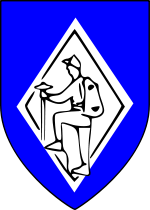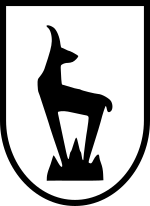
The 6th SS Mountain Division Nord was a World War II mountain infantry division of the Waffen-SS, the military wing of the German Nazi Party, primarily consisting of ethnic Germans along with some Norwegian and Swiss volunteers. It was the only Waffen-SS division to operate in the Arctic Circle.
The Fallschirm-Panzer-Division 1. Hermann Göring was a German elite Luftwaffe armoured division. The HG saw action in France, North Africa, Sicily, Italy and on the Eastern Front during World War II. The division began as a battalion-sized police unit in 1933. Over time it grew into a regiment, brigade, division, and finally was combined with the Parachute-Panzergrenadier Division 2 Hermann Göring on 1 May 1944 to form a Panzer corps under the name Reichsmarschall. It surrendered to the Soviet Army near Dresden on 8 May 1945.

The 334th Infantry Division was a German Army infantry division in World War II. Originally formed in November 1942, it surrendered to the Allies at the conclusion of the Tunisian Campaign in May 1943. The division was reconstituted on 3 June 1943 in France within the 1st Army, with the staff of the 80th Infantry Division as well as remnants of the old division and replacement units. It spent the remainder of the war serving on the Italian Front.

The 2nd Mountain Division was a Gebirgsjäger division of the German Army which served in World War II, mainly in the northernmost sector of the Eastern Front, near the Arctic. Formed in 1938, the division was disbanded at the end of the war in 1945.

The 1st Mountain Division was an elite formation of the German Wehrmacht during World War II, and is remembered for its involvement in multiple large-scale war crimes. It was created on 9 April 1938 in Garmisch Partenkirchen from the Mountain Brigade which was itself formed on 1 June 1935.

The 3rd Infantry Division was an infantry division of the German Army that fought in World War II. The division was established under the cover name Wehrgauleitung Frankfurt in 1934 by expanding the 3rd Division of the Reichswehr. It was redesignated Kommandant von Frankfurt shortly afterward, and took on its bona fide name when the formation of the Wehrmacht was announced in October 1935. In March 1939 the division took part in the invasion and occupation of Czechoslovakia.
The 4th Mountain Division was a mountain infantry division of the Heer, the army of the Wehrmacht of Nazi Germany during World War II. The division was active between October 1940 and May 1940 and participated in the Balkans campaign as well as on the Eastern Front.

The 6th Mountain Division was a German army Division of World War II. It was established in June 1940, and was deployed to France for occupation duties. In December it was relocated to Poland, where it remained until the spring of 1941. Having formed XVIII Mountain Corps with the 5th Mountain Division, it then took part in Operation Marita, the invasion of Greece during the Balkans Campaign. In September it was relocated to northern Finland, where it operated in Lapland. From July 1942 onward it was part of the 20th Mountain Army along the Arctic coast. It withdrew into Norway when the Germans evacuated Finland in late 1944, and surrendered to the British at the end of the war in 1945.
The Alpenkorps was a provisional mountain formation of division size formed by the Imperial German Army during World War I. It was considered by the Allies to be one of the best in the German Army.

The 305th Infantry Division was a German Army unit that saw extensive, front-line action during World War II. This division was present at the Battle of Stalingrad, the Battle of Monte Cassino, and surrendered to U.S. Army's 88th Infantry Division in Northern Italy near Trento in late April 1945.

Karl Hubert Lanz was a German general during the Second World War, in which he led units in the Eastern Front and in the Balkans. After the war, he was tried for war crimes and convicted in the Southeast Case, specifically for several atrocities committed by units under his command in the Balkans. Released in 1951, he joined the liberal Free Democratic Party and served as its adviser on military and security issues.

The 24th Waffen Mountain Division of the SS Karstjäger was a German mountain infantry division of the Waffen-SS, the armed wing of the German Nazi Party that served alongside but was never formally part of the Wehrmacht during World War II. At the post-war Nuremberg trials, the Waffen-SS was declared to be a criminal organisation due to its major involvement in war crimes and crimes against humanity. Named Karstjäger, the formation was one of the 38 divisions fielded by the Waffen-SS. Formed on 18 July 1944 from the SS Volunteer Karstwehr Battalion, its nominal strength was never more than theoretical and the division was soon reduced to the Waffen Mountain Brigade of the SS. Throughout its existence as a battalion, division and brigade, it was primarily involved in fighting partisans in the Karst Plateau on the frontiers of Yugoslavia, Italy, and Austria; the mountainous terrain required specialised mountain troops and equipment.

The 162nd Turkistan Division was a military division that was formed by the German Army during the Second World War. It drew its men from prisoners of war who came from the Caucasus and from Turkic lands further east.

The 4th Parachute Division,, was a divisional-sized formation in the Luftwaffe during World War II.

The 8th Mountain Division was formed on 27 February 1945 by the redesignation of the 157th Mountain Division, which itself had been formed from the 157th Infantry Division in September 1944, and which had participated in operations against the maquis of Vercors. The division was stationed in France until the Italian surrender when it then moved to Italy taking 5,772 prisoners in two days during the disarmament of the Italian Army. The division remained in Italy for the rest of the war and surrendered to the Americans in April, 1945.

42nd Jäger Division was a light infantry formation of the German Army during World War II. It can trace its origins to the 187th Infantry Division which was based in Austria until September 1942, when it was redesignated as the 187th Reserve Division. The 187th was sent to Croatia and was redesignated the 42nd Jäger Division in January 1944. 42. Jäger-Division was formed 22 Dec 1943 in Croatia from the 187. Reserve-Division. After taking part in Operation Margarthe, in March 1944, and then returned to Yugoslavia in May. In July 1944 the division was transferred to Italy where it remained for the rest of the war and surrendered in April 1945.

114th Jäger Division was a light infantry division of the German Army in World War II. It was formed in April 1943, following the reorganization and redesignation of the 714th Infantry Division. The 714th Division had been formed in May 1941, and transferred to Yugoslavia to conduct anti-partisan and Internal security operations. It was involved in Operation Delphin which was an anti-partisan operation in Croatia that took place between 15 November and 1 December 1943. The objective of the mission was to destroy the Partisan elements on the Dalmatian islands off central Dalmatia.

The 34th Infantry Division,, was a German military unit that fought in the Battle of France and on the Eastern Front during World War II. The division was first formed following the expansion of the army under Adolf Hitler's leadership, but finally disbanded following their surrender to the Americans in Italy.

The 65th Infantry Division was a German division in World War II. It was formed in July 1942.
















